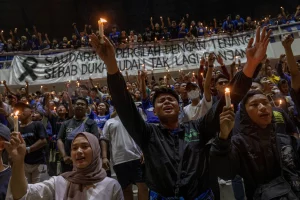On October 4, according to Japanese and South Korean authorities, the Democratic People’s Republic of Korea launched an intermediate-range ballistic missile over Japan. The missile landed 3,000 kilometers away from Japan’s archipelago, in the Pacific Ocean. The moment the Japanese government detected the missile, they sounded the warning sirens in the northern regions of Japan and asked the citizens to take shelter. It is key to note that the last time that the DPRK launched a missile over Japan was in 2017. At the time it was a strategic move to show force since the tensions between Kim Jong-un and former US president Donald Trump were rising.
For the past few months, tensions have been escalating between the DPRK and Japan. On one hand, Pyongyang has been launching more missiles, the last one being the fifth in a matter of 10 days. On the other hand, Japan seems to have been preparing itself in the case of conflict. Japan’s new Prime Minister, Fumio Kishida, ran on a platform based on modifying Japan’s pacifist constitution. Moreover, he won a supermajority in the parliamentary elections, which means that he now has the power to ask for a review of the constitution. This is an important development for regional relations, as Japan’s military could act beyond mere self-defense.
This possible change is not the only way that Japan has been preparing itself. Kishida has been working to create a stronger alliance with South Korea. For example, on July 18, Kishida met with South Korea’s foreign minister, Park Jin. The aim of the meeting was to discuss the growing threat that North Korea poses to both nations. It was the first time since 2019 that the South Korean foreign minister visited Tokyo.
More than that, the meeting is symbolic in that it shows how both nations are strengthening their alliance. Both countries have been at odds since Japan’s occupation of Korea in 1910. For the past decades, South Korean governments have asked for reparations for Japan’s role in instituting forced labor during their occupation. Until today, both nations could not reach an agreement. However, both leaders explained in July that they were working together to find a solution.
The strengthening of their alliance is already showing. After the missile launch, Seoul announced that for the first time in five years, they would be imposing unilateral sanctions on North Korea. Additionally, they will blacklist 16 organizations that are involved in the DPRK’s missile programs. Soon after the announcement was made, Yoshimasa Hayashi (Japan’s Foreign Minister) announced that Tokyo would support South Korea’s decision.
Finally, Japan is also looking to strengthen its alliances outside of the Asian Pacific region. For the first time, in June, Japan attended a NATO meeting that took place in Madrid. Not only did Kishida attend the meeting, but also one of the main topics of the meeting was the increasing tensions in the Asia-Pacific region.
Featured image by: Getty Images






